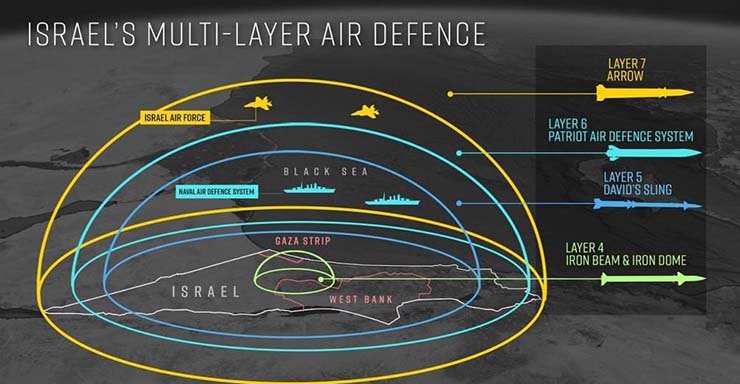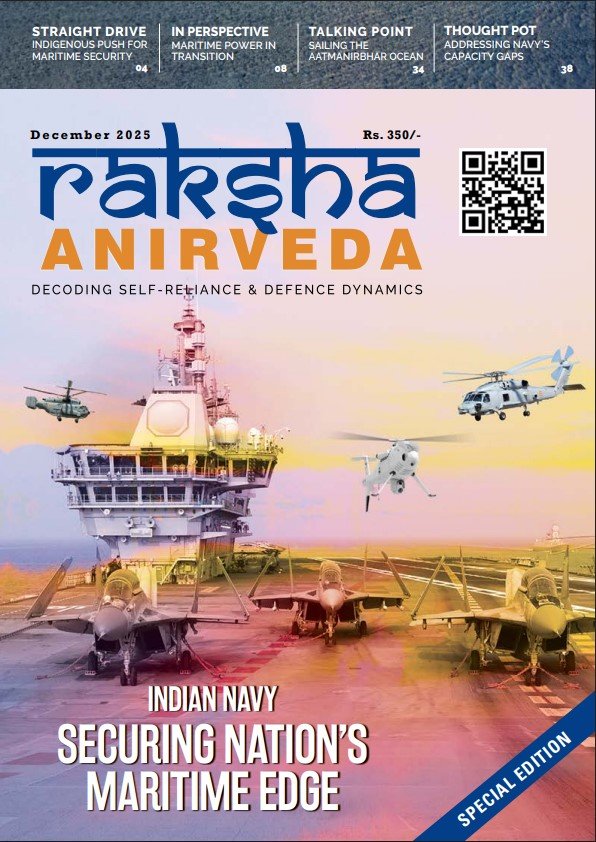Iran and Israel are pivotal states in the Middle East, each possessing unique strategic military capabilities shaped by their distinct geopolitical narratives and threats. The geopolitical dynamics between Iran and Israel have escalated into a direct confrontation, underlined by a significant military operation initiated by Iran, on 13 April 2024, at midnight. This strategic assault involved launching approximately 300 projectiles — comprising drones, cruise missiles, and ballistic missiles — targeted at Israel from various launching points across Iran, Syria, Iraq, and Yemen. This attack was in retaliation for an Israeli strike on Iran’s embassy in Syria, which resulted in the deaths of top Iranian military commanders. Despite the large scale of the attack, almost 99 per cent of the projectiles were intercepted by Israel’s advanced missile defence systems, resulting in minimal casualties and structural damage in Israel.
The Iranian attack appeared to be more of a symbolic gesture than a full-scale offensive, aiming to respond to the Israeli strike and appease domestic sentiments in Iran. Iranian officials indicated to the United States that their operations would be “limited and minimal,” focusing on a controlled and non-escalatory response. The public in Iran also celebrated the attack as a victorious response to Israeli aggressions, although the actual impact in Israel was limited. This analysis aims to objectively compare the military strengths, strategic doctrines, and technological advancements of both countries, highlighting how these factors influence regional security dynamics.
The effectiveness of Israel’s defence systems, which include the Arrow system, Spyder, David’s Sling (or Stunner), Patriot PAC-2 and PAC-3, Iron Dome, and Iron Beam, has played a crucial role in minimising the damage from the large-scale attack by Iran
Background and Development
Iran’s military strategy has historically been shaped by its desire for regional dominance and the need to deter regional rivals and international adversaries. The key conflicts, such as the Iran-Iraq war, have led to a focus on missile technology and asymmetric warfare tactics. In contrast, Israel’s military development has been driven by its need for existential security, leading to early investments in intelligence capabilities and missile defence systems, exemplified by the Iron Dome.
The global reaction has been of concern, with major powers urging restraint. The US and the UK, both allies of Israel, condemned the attack but have shown reluctance to support further escalation. President Joe Biden reassured Israel of ‘ironclad’ support for its defence, while emphasising the need for de-escalation. Other nations, including Russia and China, have also called for restraint, attributing the conflict’s extension to the ongoing issues in Gaza.
As the situation continues to be volatile, the international community watches closely, hoping for a resolution that avoids further escalation. According to U.S. officials, Israel also conducted a missile strike involving small drones targeting the Isfahan region. This mode of attack typically suggests a focus on precision and minimising unintended damage. In response, Iran’s air defence systems were activated after detecting suspicious objects in the vicinity of an army base. Fars News Agency reported that the noises heard in Isfahan were related to these defensive actions and confirmed that there was no resultant damage from the incident.
Both Iran and Israel implicitly maintain ambiguous nuclear policies as deterrents, with Israel having a reputed but undeclared nuclear arsenal, and Iran allegedly pursuing its nuclear capabilities, adding complexity to its military postures
Current Military Strengths
Despite Iran’s larger population of approximately 89 million compared to Israel’s 10 million, and its larger military force, the effectiveness of Israel’s defence systems, which include the Arrow system, Spyder, David’s Sling (or Stunner), Patriot PAC-2 and PAC-3, and Iron Dome, and Iron Beam, played a crucial role in minimising the damage from this large-scale attack (See below Figure No. 01).
Figure No. 1: Israel’s Multi-Layer Air Defence

Israel’s air defence system is highly advanced and multi-layered, designed to counter a wide variety of aerial threats. Here’s a breakdown of the key components of this system:
Arrow System
Arrow-2: This anti-ballistic missile can intercept long-range missiles within the atmosphere. It was developed in collaboration with the United States.
Arrow-3: Capable of intercepting missiles outside the Earth’s atmosphere, providing a high-altitude defence option.
David’s Sling (Stunner)
This medium-range air defence system can intercept cruise missiles, ballistic missiles, and aircraft. It covers a range of up to 300 kilometres.
Iron Dome
An indigenous short-range air defence system that can intercept rockets, artillery shells, and mortar bombs within a 70-kilometre range.
Patriot PAC-2 and PAC-3
These US-made systems are capable of intercepting a range of missiles and are effective against aircraft and drones.
Spyder
A family of multi-range mobile air defence systems designed to defend large areas against aerial attacks. Spyder systems can be activated rapidly in all weather conditions upon detecting a hostile target.
Iron Beam
Currently under development, this system aims to use laser technology to intercept incoming threats. It is a significant step forward in directed energy weapon systems, though it is not yet fully operational. These systems together provide a comprehensive shield, enhancing Israel’s capability to protect itself from varied and evolving threats in the region.
Iran’s military, though numerically superior, lacks the advanced technology and financial backing that Israel enjoys, including significant military aid from the US amounting to USD 3.8 billion annually. This disparity highlights the qualitative edge of Israel’s military capabilities over Iran’s larger but less technologically advanced forces.
Iran boasts a larger population, enabling a significant pool of military personnel. It has substantial ground forces equipped with a mix of domestically produced and imported weaponry. Its Navy controls strategic points like the Strait of Hormuz, crucial for global oil transit. Conversely, Israel, with a smaller but highly technologically advanced military, emphasises Air and Missile defence capabilities, and maintains a qualitative military edge (QME) over regional adversaries, supported by U.S. military aid (See SWOT Analysis below).
|
Aspect |
Israel |
Iran |
|---|---|---|
|
Strengths |
|
|
|
Weakness |
|
|
|
Opportunities |
|
|
|
Threats |
|
|
Source: Author’s Compilation
The strategies of Iran and Israel include forming strategic international alliances. Israel is supported by the United States and other Western nations, while Iran is with Russia and China. Still, the geopolitical isolation limits Iran’s access to cutting-edge technology.
Iran’s military doctrine is defensive but includes elements of power projection through proxy groups in neighbouring countries, reflecting its asymmetric warfare strategy. Israel’s strategy focuses on maintaining a technological edge and rapid response capabilities, crucial for countering multiple frontline threats simultaneously. Both nations implicitly maintain ambiguous nuclear policies as deterrents, with Israel having a reputed but undeclared nuclear arsenal, and Iran allegedly pursuing nuclear capabilities, adding complexity to their military postures.
Iran has developed significant indigenous military technology, notably in missile and drone warfare, to circumvent international sanctions. Israel, a global leader in military technology, invests heavily in Cybersecurity, Aerospace, and Missile Technology, with significant contributions to global arms markets. Both countries’ strategies include forming strategic international alliances; Israel with Western nations, and Iran with Russia and China, to enhance their military capabilities.
Furthermore, Iran faces severe constraints from economic sanctions, impacting its ability to upgrade its military hardware. The geopolitical isolation limits its access to cutting-edge technology. While Israel, is technologically advanced, confronts constant security threats from its immediate neighbours and allocates substantial resources to maintain its military readiness and civilian protection.
Looking Ahead
The unfolding situation puts significant pressure on regional stability and the global economy, especially considering the importance of oil exports from the region. The potential for further military engagements could disrupt oil supplies and elevate global oil prices, affecting economies worldwide, particularly those heavily dependent on oil imports like India. Its position is particularly delicate, balancing its strategic and economic relations with both Israel and Iran. With substantial populations living in both countries and critical trade partnerships to maintain, India’s call for de-escalation is driven by its complex geopolitical interests and the potential repercussions of a prolonged conflict on its own economic and strategic stability. This direct confrontation between Iran and Israel marks a significant escalation in their long-standing conflict, which has historically been fought through proxies. The international community’s response, along with the strategic decisions made by Israel and Iran in the coming days, will be crucial in shaping the future trajectory of this volatile regional conflict.
-The writer is Special Advisor for South Asia at the Parley Policy Initiative, Republic of Korea. He has authored and edited six books and has various research interests covering Sino-Indian border issues; Transboundary Rivers; Water security; Defence, and Indo-Pacific studies. He tweets @The_China _Chap. The views expressed are of the writer and do not necessarily reflect the views of Raksha Anirveda
The writer is Special Advisor for South Asia at Parley Policy Initiative, Republic of Korea. He is a regular commentator on the issues of Water Security and Transboundary River issues in South Asia. The views expressed are of the writer and do not necessarily reflect the views of Raksha Anirveda






